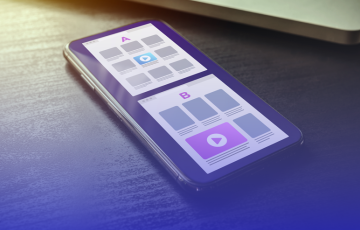
The 4 benefits of retail personalization during shopping seasons
We’re now well into the busiest time of the retail year. Given the current ultra-competitive market 2019 peak Christmas season promises to be make or break for many retailers.
The key reason for this is that ecommerce has radically changed the relationship between consumers and retailers partly thanks to personalization. Customers have an unrivalled choice of the products they buy, and where they purchase them, but limited time and normally fixed budgets. While they may visit an ecommerce website, just 2.86% convert according to industry research. Essentially nearly 97% leave empty-handed, meaning the majority of a retailer’s investment in search and online advertising to attract them has been wasted.
1 What retail customers want
What are they looking for and how can online retailers provide it? There are three key needs, beside the basic factors of offering the right products at the right price:
- They want a great experience on whatever device they use (mobile or desktop), meaning your digital UX has to be intuitive, appealing and seamless.
- They want brands to understand their needs. They don’t want to be targeted with offers or products that don’t appeal to them.
- They want retailers to respect their time. They don’t want to have to search through your website to find what they are looking for – they will simply give up and go elsewhere.
2 Putting personalization at the heart of Peak
All of these three needs can be met through effective digital personalization:
- Effective A/B testing enables you to improve the experience for all, ensuring that your website UX is right for every customer.
- Segmenting your audiences manually provides a personalized experience to specific groups, based on their behavior and other key criteria.
- You can trigger completely personalized experiences based on real-time tracking of a customer’s conversion probability through AI personalization.
Essentially personalization brings the in-store experience provided by skilled staff to digital channels. Store assistants can see what people are looking at, their physical characteristics and level of interest at a glance, and then deliver tailored service and information to help them convert. Personalization technology matches this experience, at scale, across websites offering potentially thousands of products or services.
Research by Boston Consulting Group highlights how effective personalization helps retailers. It found that 40% of consumers spent more than they originally planned when visiting websites that were highly personalized. They bought 110% more items than from sites which had low levels of personalization.
3 The 4 benefits of retail personalization
Backing up the BCG research, effective personalization delivers four key advantages to retailers in the peak shopping season:
1. Better meets customer needs
Consumers like the convenience and ease of online shopping. Compared to walking around physical shops it enables them to save time, reduces stress and opens up a world of greater choice. No wonder that 21% of UK retail spending last November was through digital channels, according to the Office of National Statistics.
However, greater choice brings its own issues. Consumers may not be able to find what they are looking for easily, or may not see the perfect gift as it is hidden deep within online sites. They don’t want to trawl through hundreds of items to locate what they are looking for. Personalization helps focus what they are seeing to items that better meet their needs, based on their previous browsing and background. At a basic level this values their time, as well as making the process easier and faster for them.
80% of consumers said they’d be more likely to make a purchase if they received a personalized experience on a retail website. Not delivering a tailored experience, such as continually offering them products similar to those that they have just bought or not recognizing them as a returning customer, all annoy customers and make them more likely to go elsewhere.
Research also shows that while consumers want their privacy to be respected, they are happy for their personal data to be used if it benefits them. 54% said they would share data if it meant they received a more personalized experience, provided they understood what information was being collected and used.
2. Increases conversions and basket sizes
Given the importance of peak, retailers clearly need to maximize sales on their websites. However, in a hyper-competitive industry, with many brands selling similar products, preserving margins is also vital. After all, there is no point in increasing conversions if you lose money on every item that is sold.
AI personalization enables you to take control with more meaningful and actionable metrics to target offers at the right audiences, where it will actually make a difference. For example, offering free shipping to those that are already converting (and happy to pay) may make them feel happier, but it impacts margins. Instead, you can analyze behavior and only trigger offers such as free shipping to those that are hesitating about buying. Urgency messages (“only 3 items left” or “there are 54 people viewing this item”) also help turn browsers into buyers.
Equally, you can use personalization to increase basket sizes through targeted offers, such as discounts or free gifts when consumers spend above a certain amount. This boosts revenues and margins by reducing the cost of each sale.
3. Enables agility
Every retailer has a plan for peak, but needs to be able to react to what is happening in the market, and what competitors are doing. This is particularly true around events such as Black Friday and Cyber Monday, where retailers need to be agile to compete successfully. Failing to respond quickly leads to missed opportunities as shoppers go elsewhere.
Personalization enables brands to automatically trigger special offers to particular segments, either in response to competitor campaigns or as a proactive effort to increase sales. You can set parameters for different personalization campaigns, meaning that they stop once you have hit your conversion objectives, maximizing your budget and margins.
4. Experience drives engagement
The reasons consumers choose to buy from a particular online retailer are many and varied. But in many cases the strongest two are price and the user experience. Competing solely on price depresses margins and can lead to losses down the line. This means that focusing on the user experience is vital if you want to really engage with consumers and turn them into committed buyers and brand advocates. Essentially you want to build a bond with them so that they come to you first because they trust that you will have the products they want, and the service and experience to match.
A/B testing every element of your site, and the personalization that you provide, helps deliver this engaging experience for every consumer. You can take decisions on changes to your site based on real data, rather than guesswork, reducing risk and leading to greater ROI.
While it is early in the current Christmas shopping season, the indications are that it will be hyper-competitive. Consumer sentiment and budgets are fragile, with increasingly savvy shoppers taking greater care over their spending. Research from the Centre for Retail Research predicts that UK Christmas spending will rise by just 0.8% compared to 2018, with total spend for the festive period estimated to be £80.27 billion.
Given these conditions, delivering a high-quality, personalized experience is therefore crucial for retailers. By delivering what consumers want, effectively and efficiently, they can boost sales, preserve margins and increase engagement, guaranteeing a Happy Christmas for both themselves and their customers.



